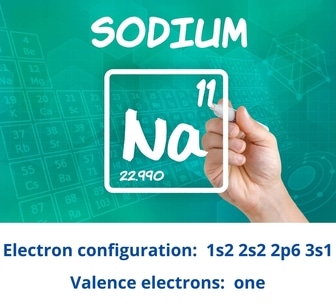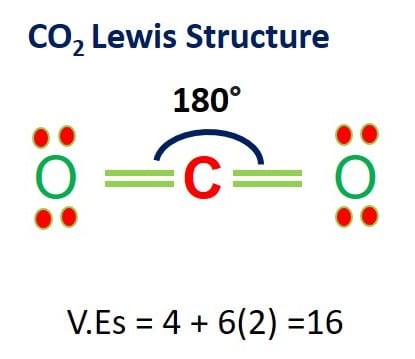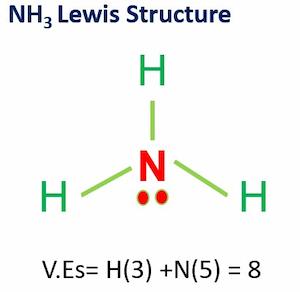Sodium has one valence electron. Valence electrons are electrons found in the outermost shell of an atom. Sodium (Na) is the eleventh element in the periodic table. It is an alkali metal that participates in the formation of bonds via one valence electron. Sodium configuration is 1s22s22p63s1. The last electron out of eleven goes to the third shell.

Table of Contents
Sodium Element
The atomic number of sodium (Na) is 11, indicating that it contains eleven protons. The number of electrons located around the nucleus is equal to the number of protons, so there are eleven electrons in a sodium atom.
The number of neutrons in an element is calculated by subtracting the number of atomic masses from the number of atoms. To put it another way, neutron number (n) = atomic mass number (A) – atomic number (Z). Since sodium has an atomic number of 11 and an atomic mass number of 22.989769, (rounded value 23). The neutron (n) is equal to 23 – 11 = 12. As a result, sodium(Na) has a total of 12 neutrons.
| Symbol | Na |
| Melting point | 882.940°C |
| Density (g/cm3) | 0.97 g/cm3 |
| Atomic mass | 22.990 |
| Atomic number | 11 |
| Classification | Alkali metal, Group I metal |
Properties of sodium
- Sodium is extremely reactive in its pure state. It’s a fairly soft metal that cuts readily with a knife. It has a silvery-white tint with a yellow flame.
- Sodium floats in water, but it also reacts aggressively when it comes into contact with it.
- When sodium combines with water, sodium hydroxide and hydrogen gas are formed.
- The most well-known sodium compounds are table salt (NaCl), sodium nitrate (Na2CO3), and baking soda (NaHCO3).
- Many of the compounds formed by sodium are water soluble.
Uses of sodium
- Sodium is an important component that the body requires in relatively small amounts (assuming no excessive perspiration) to maintain fluid balance and keep muscles and nerves operating properly.
- Significant quantities of sodium are used in the production of sodium alkyl sulfates, which are the primary constituent in synthetic detergents.
- In metallurgy, sodium is widely employed as a deoxidant and reducing agent in the manufacture of calcium, zirconium, titanium, and other transition metals.
Summary
- Electronic configuration of sodium is 1s22s22p63s1
- Sodium is an alkali metal with one valence electron.
Related Topics
Valence Electrons in Nitrogen
How many electrons does Helium have?
How many electrons does oxygen have?
Sulfur Electron Configuration
Is Nh3 Polar?
Frequently Asked Questions
1. How many electrons does iron have?
Iron contains eight electrons in its valence shell. Because iron is a transition metal, electrons in its d subshells can be used as valence electrons. In a transition metal, valence electrons are electrons that exist outside of a noble-gas core. Iron has the electrical configuration 1s22s22p63s23p64s23d6.
2. How many electrons does oxygen have?
A single oxygen atom has eight protons, eight electrons, and eight neutrons.
Oxygen is a stable isotope of oxygen with a nucleus of 8 neutrons and 8 protons. Its mass is 15.99491461956 u. Check the full topic “How many electrons does oxygen have?”.
3. How many valence electrons does sodium have?
Sodium, like all other alkali metals in group 1, has a single valence electron. Valence electrons are the outermost electrons from the nucleus and are involved in bonding.
4. What is the valence of magnesium?
Magnesium has an atomic number of 12. It has an electrical configuration of 2,8,2. As a result, it contains two valence electrons.
5. How many valence electrons does chlorine have?
Chlorine has an atomic number of 17. It has seven valence electrons.
Check the related article “Is chlorine a metal?”.
6. Molar mass of methanol?
The molar mass of methanol is 32.04 g/mol. The methanol formula is CH3OH and it is also known as methyl alcohol, wood alcohol, or wood spirit.
7. Is liquid nitrogen dry ice?
The difference between dry ice and liquid nitrogen is that dry ice is a solid form of carbon dioxide, whereas liquid nitrogen is elemental nitrogen in liquid form.
Check the full article “How cold is liquid nitrogen?”.
More Interesting Topics
HCN Lewis Structure & Molecular Geometry
CO Lewis Structure & Molecular Geometry
Density of Water in g/ml-Accurate Value
The Density of Water lbs/U.S gal
SO2 Lewis Structure| 4 Simple Steps
O2 Lewis Structure & Molecular Geometry
- BCl3 Lewis Structure in four simple steps - November 1, 2023
- PH3 Lewis Structure in four simple steps - October 8, 2023
- PF3 Lewis structure in four simple steps - September 24, 2023



